Setting Up
This chapter covers the following topics:
- Setup Overview
- Setup Flowchart and Checklist
- Setup Prerequisites
- Setup Steps
- Defining ECO Types
- Defining ECO Autonumbering
- Defining ECO Priorities
- Defining ECO Reasons
- Defining ECO Approval Lists
- Defining Material Dispositions
- Starting the AutoImplement Manager
- Engineering Profile Options and Security Functions
- Profile Option Settings
- Profile Options
Setup Overview
This section contains an overview of each task you need to complete to set up Oracle Engineering.
Before you set up Oracle Engineering, you should:
-
Set up an Oracle Applications System Administrator responsibility. See: Oracle System Administration, Oracle E-Business Suite System Administrator's Guide.
Setup Flowchart and Checklist
Some of the steps outlined in this flowchart and setup checklist are Required and some are Optional. Required Step With Defaults refers to setup functionality that comes with pre-seeded, default values in the database; however, you should review those defaults and decide whether to change them to suit your business needs. If you want or need to change them, you should perform that setup step. You need to perform Optional steps only if you plan to use the related feature or complete certain business functions.
The diagram below is described in detail in the Setup Checklist table, and Setup Steps section that follow.
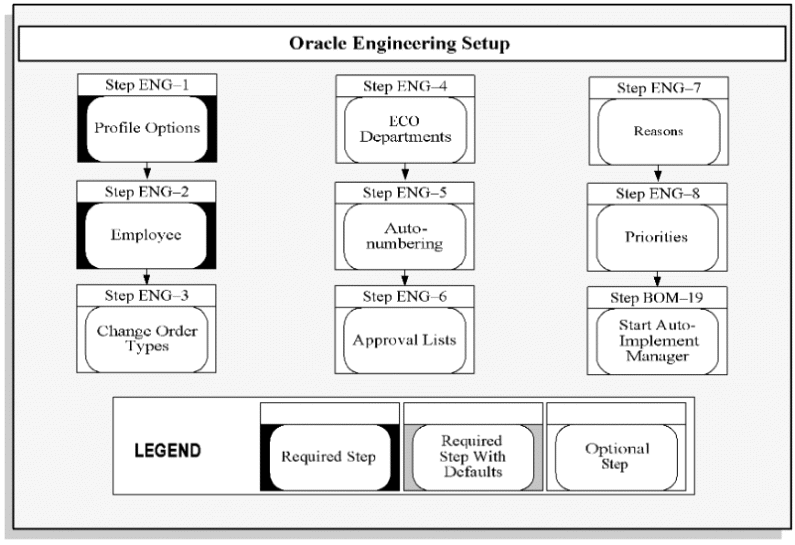
The following table lists setup steps. After you log on to Oracle Applications, complete these steps to implement Oracle Engineering:
| Step No. | Required | Step |
| Step 1 | Required | Set Profile Options |
| Step 2 | Required | Enter Employee |
| Step 3 | Optional | Define Change Order Types |
| Step 4 | Optional | Define ECO Departments |
| Step 5 | Optional | Define Autonumbering |
| Step 6 | Optional | Define Approval Lists |
| Step 7 | Optional | Define Material Dispositions |
| Step 8 | Optional | Define Reasons |
| Step 9 | Optional | Define Priorities |
| Step 10 | Optional | Start AutoImplement Manager |
Setup Prerequisites
Before you set up Oracle Engineering, you must complete the setup for the following:
In Oracle Inventory:
-
Define items. See: Defining Items, Oracle Inventory User's Guide
In Oracle Bills of Material:
-
See: Setting Up, Oracle Bills of Material User's Guide
Setup Steps
-
Set Profile Options (Required)
Profile options specify how Oracle Engineering controls access to and processes data. In general, profile options can be set at one or more of the following levels: site, application, responsibility, and user.
Oracle Engineering users use the Update Personal Profile Options form to set profile options only at the user level. System administrators use the Update System Profile Options form to set profile options at the site, application, responsibility, and user levels.
Context: Perform this step once for each entity, that is, site, application, responsibility, or user.
-
Enter Employee (Required)
Define employees for your organization. ECO requestors and approvers must be defined as employees.
If you do not install Oracle Human Resource Management Systems with Oracle Engineering, you use the Enter Employee form to define and maintain employees in Oracle Engineering.
If you install Oracle Human Resource Management Systems, you use the forms in Oracle Human Resource Management Systems instead to enter and maintain employees.
Context: Perform this step once for each entity organization.
-
Define Change Order Types (Optional)
You can assign a change order type to your ECOs, either using the ECO change order type that Oracle Engineering provides or choosing a change order type from any number of types you define using your own terminology, such as Design Revision, Manufacturing Change Order, or Substitution Waiver. You can create change order types for ECOs with manufacturing items, or manufacturing and engineering items.
Default: If you skip this step, Oracle shipped change order types will be used as the default value.
Context: Perform this step once per installation.
-
Define ECO Departments (Optional
You can group users that use the engineering change order (ECO) system through ECO departments, creating multiple ECO departments within your Inventory organization. You can restrict access to ECOs by ECO department and require an ECO department on all ECOs-changing the responsible ECO department as the ECO moves through multiple departments.
Default: If you skip this step, <enter value here> will be used as the default value.
Context: Perform this step once per organization.
-
Define Autonumbering (Optional)
You can define customized autonumbering (for a user, organization, or site) for new ECOs or mass change orders. You can use the autonumber default value when you define an engineering or mass change order, or you can override the autonumber default and assign your own number.
Context: Perform this step once per organizational user.
-
Define Approval Lists (Optional)
You can define lists of approvers required to approve an ECO before it can be released. Oracle Engineering notifies the people on the list, using an alert, that the ECO requires their approval.
Context: Perform this step once per installation.
-
Define Material Dispositions (Optional)
You can define your own customized material dispositions, and then assign them to revised items when defining ECOs.
-
Define Reasons (Optional)
You can define reasons for engineering change orders using your own terminology, such as Model Year, Design, Safety, and Ergonomic. ECO reasons are for your reference use only.
Default: If you skip this step, Oracle shipped reasons will be used as the default value.
Context: Perform this step once per organization.
-
Define Priorities (Optional)
You can define scheduling priorities for engineering changes to describe the urgency of your ECO. Priorities are for your reference use only.
Default: If you skip this step Oracle shipped priorities will be used as the default value.
Context: Perform this step once per organization.
-
Start AutoImplement Manager (Optional)
If you automatically implement ECOs, you must specify the frequency that you want the AutoImplement manager to run. Once an ECO has been released to the autoimplement manager, you can automatically implement all scheduled ECO revised items whose effective date is less than or equal to the current date.
Related Topics
Starting the AutoImplement Manager
Defining Material Dispositions
Oracle Engineering Profile Options and Security Functions
Defining ECO Types
Engineering change order (ECO) types help classify engineering and mass change orders to items and bills of material, and determine whether such orders apply to engineering in addition to manufacturing.
An ECO type can be associated with an Oracle Workflow process. If so, a priority can optionally be associated with the ECO type.
If you define an ECO using a type and priority combination (even if the priority is blank) that is associated with a workflow process, Workflow will control the ECO approval process. If the type and priority combination is not associated with a workflow process, the ECO approval status defaults to Approved.
Use this form to define and update change order types that determine the types of items and bills of material you can modify on mass change orders.
Note: You can now create an engineering change order type in the Change Types window with a name of up to 80 characters in length in the Type field. Previously, the name of an engineering change order type was limited to 10 characters.
You can now set up engineering change order types in the Change Types window in multiple languages.
To define an ECO type
-
Navigate to the Change Types window.
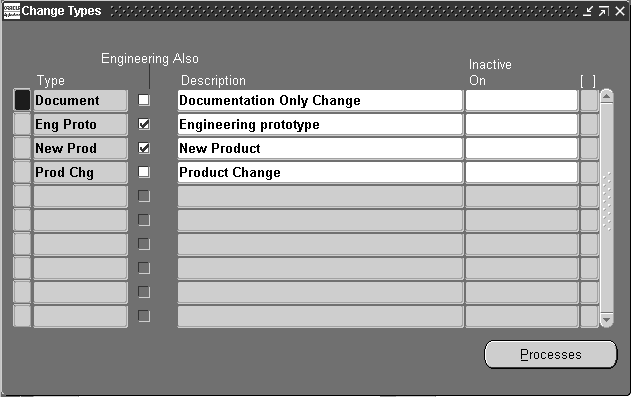
-
Enter alphanumeric text for a unique change order type.
-
Indicate whether the change order type can revise both engineering and manufacturing items and bills.
ECOs with an engineering change type can include both engineering and manufacturing items. ECOs with a manufacturing change type cannot include engineering items.
If an ECO with a status of Open, Hold, Release, or Schedule is using this ECO type, this value cannot be updated.
You must choose the Manufacturing option in this field for Oracle Engineering.
-
Optionally, enter a description for the change order type.
-
Enter a date to inactivate the change order type. As of this date, you can no longer assign this change order type to a change order.
-
To associate this ECO type with a Workflow process, choose the Processes button.
If you do not associate this ECO type with a Workflow process, any ECO using this type will default to Approved.
To associate an ECO type with a Workflow process
-
Navigate to the Change Type Processes window. Do this by choosing the Processes button from the Change Types window.
-
Optionally, select an ECO priority.
Note: ECO types are not organization-specific. However, ECO priorities are organization-specific. This ECO type-priority combination will only be available in the current organization.
-
Select a workflow process to associate with this ECO type.
Whenever this type and priority combination (even if priority is blank) is used for an ECO, Workflow will control the ECO approval process.
Related Topics
Overview of Engineering Change Orders
Engineering Change Order Types Report
Defining ECO Autonumbering
You can define and update customized autonumbering to use as defaults when creating new engineering change orders (ECOs) and mass change orders.
Define autonumbering for a particular user in an organization, a user across all organizations, all users in one organization, or all users across all organizations.
When you first define an ECO, Engineering uses the following hierarchy to determine the prefix to use for autonumbering:
-
Specific prefix for you and your current organization
-
Specific prefix for you across all organizations
-
Specific prefix for all users for your current organization
-
Specific prefix for all users across all organizations
For example, if a prefix is set up for you and the current organization, it supersedes a prefix defined for you across all organizations.
When defining an ECO, you can either accept a default ECO number or manually enter one. Engineering displays the prefix along with the next available number. If Engineering does not find an autonumbering prefix, you must assign an ECO number manually.
Important: When creating an ECO, once a default ECO autonumber displays, Engineering considers that number used, even if you do not save your changes and create the ECO using that number. For example, if you begin to define an ECO called ABC234, and then decide to abandon your changes, Engineering presents the next ECO number as ABC235. You can manually change this number.
To define ECO autonumbering
-
Navigate to the ECO Autonumbering window.

-
Enter or select a specific UserName to define autonumbering for a particular user, or select the All Other Users record to define autonumbering for all other users.
If you have privilege only to define autonumbering for yourself, the default is your username.
-
Enter a specific organization to define autonumbering for a particular organization, or select the All Other Organizations record to define autonumbering for all other organizations.
Important: The information you provide in the Organizations region is associated with the specific user or the All Other Users record in the Users region.
-
Enter a prefix to use as the first characters for each defaulted ECO identifier for the specific user or All Other Users, whichever is currently selected.
You can define only one prefix per user per organization. You can define only one prefix per user across all other organizations.
-
Enter a Next Number to use as the of the base of the numeric portion of ECO autonumbering.
The combined prefix and next number-the autonumber-is incremented when each ECO is created. For example, if you enter 100 and your prefix is ABC, the first ECO number is ABC100. The next will then be ABC101.
Each new ECO number is defaulted to one integer plus the last used ECO number. When defining a new ECO, you can override this with a higher value. The next ECO number will then be one integer greater. For example, assuming ABC as the prefix and no ECOs defined using ABC, ABC1 is the default. If you have defined an ECO called ABC234, ABC235 is the default.
You cannot enter a prefix and next number that, when used together, exceeds ten alphanumeric characters.
Related Topics
Defining ECO Priorities
Engineering change priorities enables you to specify the urgency of the engineering change order. You can define a priority, enter a description, and enter a priority level between zero and nine.
Note: ECO priorities can be specified when associating ECO types with Oracle Workflow processes, which are used for ECO approvals.
To define an ECO priority
-
Navigate to the ECO Priorities window.

-
Enter alphanumeric text to describe a unique priority for an ECO. For example, you could enter 1 to indicate an important priority.
-
Enter a priority sequence. This is a number between 0 and 9. For example, you can use 0 to denote the highest priority and 9 the lowest.
-
Enter a description for the priority.
-
Optionally, enter a date on which the priority becomes inactive. As of this date, you can no longer assign the priority to an ECO.
Related Topics
Engineering Change Order Priorities Report
Defining ECO Reasons
Use engineering change reasons to categorize and identify causes for ECOs. Engineering uses ECO reasons for reference only.
To define an ECO reason
-
Navigate to the ECO Reasons window.
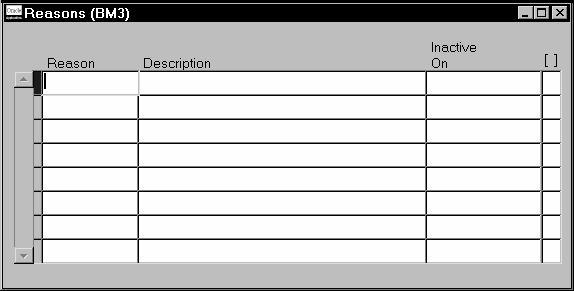
-
Enter alphanumeric text to describe a unique reason for initiating an engineering change. For example, you could define a reason obsolete to indicate an obsolete part, or waiver to indicate a component change on a bill of material.
-
Enter a description of the ECO reason.
-
Enter a date on which the reason becomes inactive. As of this date, you can no longer assign the reason to an ECO.
Related Topics
Engineering Change Order Reasons
Defining ECO Approval Lists
Engineering lets you define lists of approvers for ECOs. Each approval list can be used as a role by Oracle Workflow.
One workflow process, named Standard Approval Process, is installed with Engineering.
To define an ECO approval list
-
Navigate to the Approval Lists window.
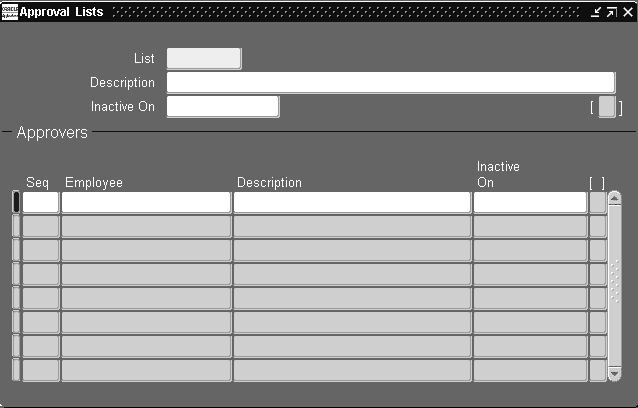
-
Enter the approval list name, a description, and, optionally, a date on which you can no longer assign the approval list to an ECO.
-
Enter a sequence for the approver. This number indicates the sequence of the approver for the ECO. Engineering uses this for information purposes only.
-
Enter a date for this approver on the approval list. As of this date, the approver is no longer notified when an ECO requires their approval.
Related Topics
Engineering Change Order Approval Lists Report
Defining Material Dispositions
Engineering enables you to define customized material dispositions. You can then assign them to revised items when defining an ECO.
To define a material disposition
-
Navigate to the Material Dispositions Lookups form and define your material disposition.
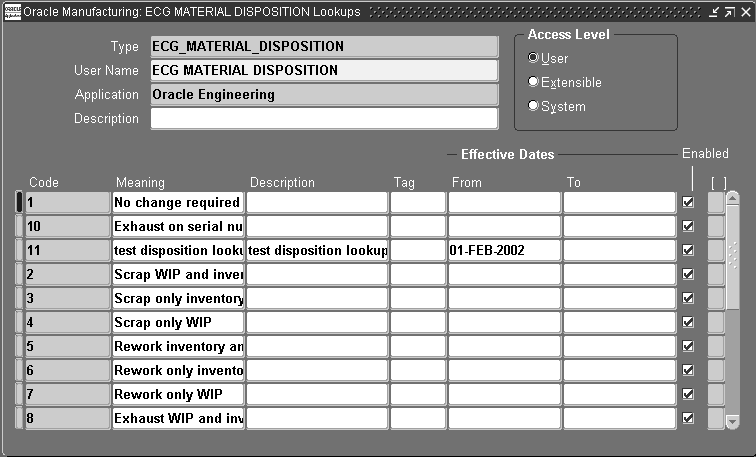
-
Enter a new code and description for your material disposition.
-
Save your work.
-
Navigate to the Revised Items window and assign your material disposition to revised items.
Related Topics
Starting the AutoImplement Manager
The AutoImplement Manager runs at the specified dates and times and automatically implements items whose schedule dates occur on or before the current date. Engineering change orders or revised items whose status is Scheduled are automatically implemented.
To start the AutoImplement Manager
-
Navigate to the Start AutoImplement Manager window.
-
Enter or select the Automatic Engineering Change Order Implementation program.
-
Enter the dates and times when to run the ECO auto implement process.
Related Topics
Engineering Profile Options and Security Functions
During implementation, the system administrator sets up and maintains security functions and profile options.
A security function determines whether an Engineering Change Order (ECO) approval Workflow process can be submitted or aborted.
Engineering Change Orders: Cancel (ENG_ENGFDECN_CANCEL)
Determines whether ECOs can be cancelled.
Engineering Change Orders: Implement (ENG_ENGFDECN_IMPLEMENT)
Determines whether ECOs can be implemented.
Engineering Change Orders: Release (ENG_ENGFDECN_RELEASE)
Determines whether ECOs can be released.
Engineering Change Orders: Reschedule (ENG_ENGFDECN_RESCHEDULE)
Determines whether ECOs can be rescheduled.
Engineering Change Orders: Schedule (ENG_ENGFDECN_SCHEDULE)
Determines whether ECOs can be scheduled.
Engineering Change Orders: Update (ENG_ENGFDECN_UPDATE)
Determines whether ECOs can be updated.
Engineering Items: Delete (ENG_INVIDITM_DELETE)
Determines whether engineering items can be deleted from the Bills of Material or Routings windows.
Engineering Items: Revisions (ENG_INVIDITM_REVISIONS)
Determines whether revisions for engineering items can be updated.
Engineering Items: Transfer (ENG_INVIDITM_TRANSFER)
Determines whether engineering items can be transferred to manufacturing.
Profile Option Settings
You can set or view the following profile options in Oracle Order Entry/Shipping. The following table includes some profile options from other applications that are used by Engineering.
| Profile Option | User | User | Resp | App | Site | Required? | Default Value |
|---|---|---|---|---|---|---|---|
| ENG: Change Order Autonumbering - System Administrator Access | - | Y | Y | Y | Y | Required | No |
| ENG: ECO Department | - | Y | Y | Y | Y | Optional | No |
| ENG: ECO Revision Warning | - | 0 | 0 | 0 | Y | Optional | No |
| ENG: Engineering Item Change Order Access | - | Y | Y | Y | Y | Optional | Yes |
| ENG: Mandatory ECO Departments | - | 0 | 0 | 0 | Y | Optional | No |
| ENG: Model Item Change Order Access | - | Y | Y | Y | Y | Optional | Yes |
| ENG: Planning Item Change Order Access | - | Y | Y | Y | Y | Optional | No |
| ENG: Require Revised Item New Revision | - | 0 | 0 | Y | Y | Optional | No |
| ENG: Standard Item Change Order Access | - | Y | Y | Y | Y | Optional | Yes |
| ENG: Allow Eng Comps for MFG Items in ECO | - | - | 0 | Y | Y | Optional | Yes |
| ENG: MRP Active Flag default for ECO | - | - | 0 | Y | Y | Optional | Yes |
| ENG: Update Unreleased WIP Jobs | Y | Y | Y | Y | Y | Optional | Yes |
| ENG: Internal User Default Role for Changes | - | - | 0 | 0 | Checked | Optional | Yes |
| Y | You can update the profile option. |
| - | You can view the profile option value but you cannot change it. |
| 0 | You cannot view or change the profile option value. |
Profile Options
You can set or view profile options in Oracle Engineering. The profile options mentioned in the preceding table are described here.
ENG: Allow ENG COMPS for MFG Items in ECO
When this profile option is set to Yes, you can add engineering components to a manufacturing bill of material, but you must transfer the engineering component to manufacturing before implementing the engineering change order. When this profile option is set to No, you cannot add engineering components to a manufacturing bill of material.
Indicates the default department Engineering uses when you define an ECO. An ECO department is the department currently responsible for an ECO. It restricts departments from updating ECOs for which they are not responsible.
Indicates whether to raise a warning but still implement ECO revisions with pending lower level revisions (Yes), or to raise an error and not perform the implementation (No or blank). A blank (or “null") value is equivalent to No.
ENG: Engineering Item Change Order Access
Indicates whether a Change Order Type allowing the "Engineering Also" is available for selection. Set to No the Change Order Types which do not have the "Engineering Also" attribute selected.
ENG: Mandatory ECO Departments
Indicates whether it is mandatory to assign a department to each ECO so you can enforce a security policy.
ENG: Model Item Change Order Access
Indicates whether you can revise model and option class items on ECOs.
ENG: MRP Active flag default for ECO
Indicates the default active flag for ECO revised items.
ENG: Planning Item Change Order Access
Indicates whether you can revise planning items on ECOs.
ENG: Require Revised Item New Revision
Indicates whether it is mandatory to assign a new revision to revised items on ECOs. A blank (or “null") value is equivalent to No.
ENG: Standard Item Change Order Access
Indicates whether you can revise standard items on ECOs.
ENG: Update Unreleased WIP Jobs
Indicates if you can update unreleased WIP jobs.
ENG: Change order Autonumbering-System Administrator Access
Indicates whether you can define ECO autonumbering for all users or for yourself only.
ENG: Internal User Default Role for Changes
This is one of the roles than can be configured. The roles are used to define a set of privileges for the user. The roles are mentioned below:
Approver: User can approve the change order, may have edit privileges
Owner: User that submits the change order and has edit or read privileges
Reviewer: User can read the change order and material associated with the change order and has no edit privileges.
Related Topics
Overview of Function Security, Oracle E-Business Suite System Administrator's Guide
Implementing Function Security, Oracle E-Business Suite System Administrator's Guide
Setting Your Personal User Profile, Oracle E-Business Suite User's Guide
Common User Profile Options, Oracle E-Business Suite User's Guide
Profile Options in Oracle Application Object Library, Oracle E-Business Suite User's Guide